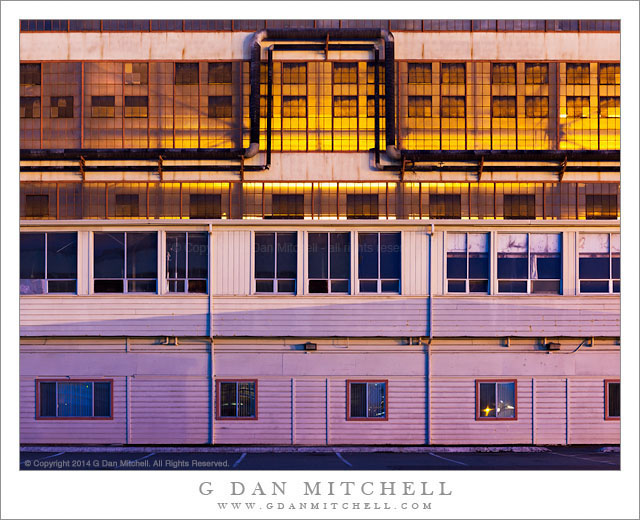
Industrial Building, Mixed Lighting. Mare Island Naval Ship Yard, Vallejo, California. April 5, 2013. © Copyright 2014 G Dan Mitchell – all rights reserved.
Numerous sources of artificial light illuminate an industrial building from outside and inside
I like night photography for a number of reasons. I enjoy the very slow work, finding subjects and compositions in near darkness and then waiting patiently for long exposures to complete. “Normal” photography can be a slow and meditative process, but night photography must be. Given so much time to stand and wait, I cannot help but notice the stillness and quiet of the night, and to feel the cool and damp air. In fact, as a person who does night photography, these things are almost as much part of the experience as the visual elements.
In the visual context, there are a few things about the appeal of night photography that might not occur to a person who has not done it. When photographing in very low light, what we photograph is often very different from what we actually see. Often the subject is quite dark, even when lit by the moon or nearby lights, but the camera doesn’t care—a long enough exposure can collect more light that our eyes can, and a dim and drab subject can become bright. Also, the illusion that the camera stops time is not quite so strong when photographing at night. Over the course of a many minutes long exposure stars move, lights of cars appear and pass, clouds blur into soft streaks, and the edges of shadows from moonlight blur. In industrial areas such as this one, the lighting is a mixture of things glowing from within and lit from without, and the diversity of lighting—tungsten, fluorescent, sodium vapor, LED, mercury vapor, moonlight—paints the nightscape with wild colors. This building is an excellent example. The upper windows emanate a glow from yellow interior light. Relatively colorless light hits the upper walls, but the light takes on an odd blue/pink tone on the lower building, and the shadows head toward blue.
 G Dan Mitchell is a California photographer and visual opportunist whose subjects include the Pacific coast, redwood forests, central California oak/grasslands, the Sierra Nevada, California deserts, urban landscapes, night photography, and more.
G Dan Mitchell is a California photographer and visual opportunist whose subjects include the Pacific coast, redwood forests, central California oak/grasslands, the Sierra Nevada, California deserts, urban landscapes, night photography, and more.
Blog | About | Flickr | Twitter | Facebook | Google+ | 500px.com | LinkedIn | Email
Text, photographs, and other media are © Copyright G Dan Mitchell (or others when indicated) and are not in the public domain and may not be used on websites, blogs, or in other media without advance permission from G Dan Mitchell.
Discover more from G Dan Mitchell Photography
Subscribe to get the latest posts sent to your email.

Jerry, the color palette in this photograph is one of the oddest that I’ve come up with at Mare Island, a place where unusual combinations of light sources are the rule more than the exceptions. (Although… as I’ve written recently, with the installation of energy-efficient LED lighting there, things are becoming a bit bland in places.)
I have encountered the yellowish light many times at Mare Island. It is common (and used to be more common) from both tungsten and (especially) sodium vapor lamps. The odd thing here is the pinking light inside the shaded area along the lower front of the building. I’d have to go back to see what the heck that came from. (Sometimes odd lighting colors are revealed in shadows, which may be lit faintly by sources that are farther away from the subject.)
I was just thinking about those pipe shapes yesterday. One of the most striking examples I know of is the Searles Valley “mining” facility at Searles Lake in Trona, California. There very long runs of pipe come in from the lake bed and they are broken up by these square shaped bends every so often. I’ve often assumed that it might have something to do with accommodating expansion and contraction of the pipes.
The sensual quality of the colors in this image contrast in an intriguing way with the regimented, utilitarian architectural elements creating an interesting dichotomy. I don’t know if that’s what you intended, or if you intended anything at all. I’m not of the opinion that an image needs to “say” something or make a statement. I like the way David DuChemin says that photographs do not necessarily need to be “understood”, sometimes it’s about “experiencing” them (or words to that effect).
As an aside: I am curious as to why the pipes at the top of the frame make a detour requiring four ninety degree turns instead of just continuing in a straight line… But then, I’m just weird.